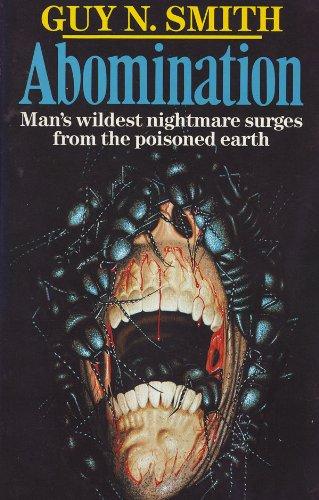“Abomination” is a horror novel by Guy N. Smith, published in 1986. Smith, known for his prolific output and knack for creating gripping, often gruesome horror stories, delivers another intense and chilling narrative in this novel.

Plot Summary
In the cutthroat world of agrochemicals, Franklin Roeder stands at the helm of innovation, poised to revolutionise pest control with his latest creation—a killer pesticide spray engineered to decimate insect populations with ruthless efficiency. Drawing inspiration from the principles of weedkiller, Roeder’s invention promises to usher in a new era of agricultural dominance, where pests are vanquished with ease.
The initial success of Roeder’s pesticide is nothing short of monumental. Across fields and forests, creatures of all sizes fall victim to its potent effects, succumbing to bloated demise as the spray takes hold. Yet, as Roeder soon discovers, success comes with a deadly caveat—while the pesticide proves adept at incapacitating its targets, many stubbornly cling to life, defying all attempts at eradication.
Undeterred by setbacks, Roeder resorts to deception, coercing his lab scientists into falsifying reports to expedite the pesticide’s release. As the wheels of industry churn, a sinister truth emerges—the effects of Roeder’s spray spawn a plague of oversized, ravenous insects, hungry for flesh and blood.
In “The Harvest of Fear,” author Guy masterfully navigates the treacherous waters of corporate greed and scientific ambition, crafting a tale that resonates with chilling relevance in an age of unchecked technological advancement. Through Roeder’s relentless pursuit of profit at any cost, the narrative explores themes of ethical responsibility and the perils of unchecked power, offering a sobering reflection on the consequences of humanity’s relentless quest for dominance over the natural world.
As the line between predator and prey blurs, readers are drawn into a world where the boundaries of morality are tested and the price of progress exacts a heavy toll. With its gripping story line and thought-provoking premise, “The Harvest of Fear” delivers a riveting exploration of the dangers that lurk beneath the veneer of progress, leaving readers breathless with anticipation until the final, chilling conclusion.
Themes and Style
- Violence and Survival: The novel delves into extreme violence and the primal instinct for survival. It portrays the lengths to which people will go when pushed to their limits.
- Corruption and Exploitation: “Abomination” critiques the moral corruption of society, especially among the wealthy who exploit others for their entertainment.
- Psychological Horror: Beyond the physical brutality, the novel explores the psychological impact on those involved, highlighting themes of fear, desperation, and the loss of humanity.
- Reception
- “Abomination” garnered attention for its intense and graphic portrayal of violence and its critique of human depravity. Fans of Guy N. Smith’s work appreciated the novel’s fast-paced, relentless narrative and its ability to evoke a sense of horror and unease. However, some critics found the graphic content and bleak themes challenging to engage with.
Author Background
Guy N. Smith (1939-2020) was a British author renowned for his extensive contributions to the horror genre. With over 100 novels, Smith’s works often feature elements of the supernatural, environmental disasters, and human depravity. He is perhaps best known for his “Crabs” series, which centers around giant, killer crabs terrorizing humanity.
Legacy
While “Abomination” may not be as widely known as some of Smith’s other novels, it remains a notable entry in his body of work. The novel’s exploration of extreme violence and its critique of societal corruption continue to resonate with readers who appreciate dark and intense horror fiction.
Overall, “Abomination” is a compelling example of Guy N. Smith’s ability to craft horror stories that delve deep into the darker aspects of hum